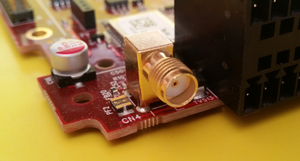TS-7180 GPS: Difference between revisions
No edit summary |
(Clean up GPS text and mention how to start gpsd at boot) |
||
| (One intermediate revision by the same user not shown) | |||
| Line 1: | Line 1: | ||
[[File:TS-7180-GPS-Antenna.png|300px]] | [[File:TS-7180-GPS-Antenna.png|300px]] | ||
The TS-7180 has an optional on-board [http://www.telit.com/gnss/sl869/ Telit SL869] GPS receiver. An SMA female connector is provided for | The TS-7180 has an optional on-board [http://www.telit.com/gnss/sl869/ Telit SL869] GPS receiver, accessible at <code>/dev/ttymxc7</code>, through which the GPS provides NMEA strings. An SMA female connector is provided for attaching an antenna. | ||
The GPS power is controllable through a GPIO. For example: | The GPS power is controllable through a GPIO. For example: | ||
| Line 8: | Line 8: | ||
gpioset 5 19=0 # turn off GPS | gpioset 5 19=0 # turn off GPS | ||
</source> | </source> | ||
By default the GPS module is powered on. | By default, the GPS module is powered on when the board starts up. | ||
A typical way of interfacing with the GPS is using gpsd. For example, under Debian: | A typical way of interfacing with the GPS is using <code>gpsd</code>. For example, under Debian, load these packages: | ||
<source lang=bash> | <source lang=bash> | ||
apt install gpsd gpsd-clients -y | apt install gpsd gpsd-clients -y | ||
</source> | </source> | ||
Then edit /etc/default/gpsd and change these two | Then edit <code>/etc/default/gpsd</code> and enable and/or change these two variables: | ||
< | <syntaxhighlight lang="bash"> | ||
# Devices gpsd should collect to at boot time. | # Devices gpsd should collect to at boot time. | ||
# They need to be read/writeable, either by user gpsd or the group dialout. | # They need to be read/writeable, either by user gpsd or the group dialout. | ||
| Line 22: | Line 22: | ||
# Other options you want to pass to gpsd | # Other options you want to pass to gpsd | ||
GPSD_OPTIONS="-n" | GPSD_OPTIONS="-n" | ||
</ | </syntaxhighlight> | ||
Then restart gpsd: | Then restart gpsd: | ||
| Line 29: | Line 29: | ||
</source> | </source> | ||
For testing, run <code>gpsmon</code> to see lock, coordinates, and time information. | |||
You will likely want <code>gpsd</code> to start automatically at boot. To make this always happen, type: | |||
<source lang=bash> | |||
systemctl enable gpsd | |||
</source> | |||
Finally, the following article describes writing clients that interface with <code>gpsd</code>, which can do so from most programming languages: | |||
* [https://gpsd.gitlab.io/gpsd/client-howto.html gpsd writing clients] | * [https://gpsd.gitlab.io/gpsd/client-howto.html gpsd writing clients] | ||
Latest revision as of 16:01, 31 August 2021
The TS-7180 has an optional on-board Telit SL869 GPS receiver, accessible at /dev/ttymxc7, through which the GPS provides NMEA strings. An SMA female connector is provided for attaching an antenna.
The GPS power is controllable through a GPIO. For example:
gpioset 5 19=1 # turn on GPS
gpioset 5 19=0 # turn off GPS
By default, the GPS module is powered on when the board starts up.
A typical way of interfacing with the GPS is using gpsd. For example, under Debian, load these packages:
apt install gpsd gpsd-clients -y
Then edit /etc/default/gpsd and enable and/or change these two variables:
# Devices gpsd should collect to at boot time.
# They need to be read/writeable, either by user gpsd or the group dialout.
DEVICES="/dev/ttymxc7"
# Other options you want to pass to gpsd
GPSD_OPTIONS="-n"
Then restart gpsd:
service gpsd restart
For testing, run gpsmon to see lock, coordinates, and time information.
You will likely want gpsd to start automatically at boot. To make this always happen, type:
systemctl enable gpsd
Finally, the following article describes writing clients that interface with gpsd, which can do so from most programming languages:
